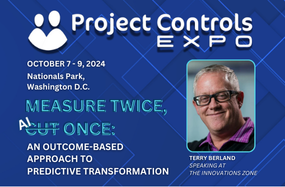
The 7 Sins of Collaborative Budget Planning

Contributed By Kristy Neckowicz, InVizion LLC
Everyone knows manual processes do not scale, and ineffective communication leads to execution problems. Yet, these issues are all too prevalent in large organizations when planning a significant budget involving many people across multiple groups, programs, and projects. Conscientious planners and analysts must rapidly model competing priorities and demands from different stakeholder groups, and then evaluate and clearly present optimal scenarios to executives for budget allocation decisions. For businesses to succeed in today’s challenging business environment, there are seven common pitfalls to avoid:
1. Overlooking Cause and Effect
Planners and analysts are tasked with creating budget plans that are accurate and dynamic, with the ability to change the inputs and analyze the impact on outputs; however, with inflexible financial systems and stacks of standalone spreadsheets, it is challenging and time-consuming to manually model the various drivers and their varying degrees of cascading impacts. Without the right tool to easily model cause and effect, strategic financial decisions that should be data-driven are too often made based on gut-feel, generally referred to as “expert opinion.”
2. Ignoring Interdependencies
The effectiveness of some projects and investments are dependent on the successful completion of other projects or investments. These logical interdependencies among investments or projects should be tracked and accurately reflected. When interdependencies are missing in budget models, decisions get made as if projects and investments are completely autonomous and independent. When an investment is delayed, a model needs to include the domino effect it has on other investments and their collective benefits. Ignoring interdependencies results in unrealistic expectations of returns on investment, higher risks, and increased life cycle costs. One way of integrating interdependencies into your budget planning is by using advanced project planning and risk management tools hosted in the cloud. Your spreadsheets can be tied to real-time project data that is shared across all the required stakeholders, with one unified portal to log into and distribute data across.
3. Using your brain for remembering, instead of thinking
The most conscientious planners and analysts end up spending an inordinate amount of time on manual spreadsheets. They have to chase formulas among cells on dozens of related worksheets. Lookup tables are used that are error-prone when numbers on other worksheets are revised. Certain cells have to be manually adjusted every time a change is made, and then other worksheets must be adjusted. Spreadsheets have no built-in time awareness, so time buckets and sequences have to be created manually, and formulas and pivot tables have to summarize the right columns and rows for subtotals by group, by quarter, by month, by whatever. All this manual manipulation—just to avoid mistakes in budget models—takes away valuable time and brainpower from performing accurate and reliable analysis.
4. Insufficient “what-if” analysis
What are the best investments to be made with available capital to drive a business forward? What are some different options to adjust the budget roadmap or spend plans in order to be as close to target as possible without going over? Planners and analysts need to compare multiple “what-if” scenarios to evaluate each scenario’s impact on costs, risks, goals, and objectives. Without these scenario comparisons, how can someone objectively demonstrate the optimal scenarios are being recommended—the ones most aligned with objectives and constraints—while reducing uncertainty and increasing confidence in business decisions?
5. Can’t see the forest for the trees
Bottom-up budget plans are useful until they cause delays in your “what-if” analysis and stifle the ability to make timely decisions. When top-down changes or significant variances occur that require adjustment of spend plans, the ability to quickly and objectively model impacts of different options in sufficient detail is needed. The key is to be able to assess the effects at a level not too high to be meaningful, but also not at a time-consuming gnat’s eyelash level of detail in bottom-up plans.
6. Throwing spreadsheets over the wall
Even after you have completed sufficient “what-if” analysis and identified an optimal budget plan, it would be a mistake to just throw it over the wall to the performing stakeholder groups. For businesses to realize a successful outcome, key performing stakeholders need to be enrolled in the process to recognize the optimal solution(s) and to get their agreement to implement it. Stakeholder engagement and enrollment are critical and need to include swift reviews of scenario comparisons while gathering meaningful feedback and minimizing time-consuming iterations.
7. Resisting Change
Just because we are comfortable with the current “standard” process of budget planning does not mean it should continue to be done that way. History has shown that when we overcome our natural human resistance to change, the benefits of change can far outweigh the comforts of “staying the same.” For example, utilizing a cloud software provider such as LoadSpring to host your project management and specialized tools could be just the type of change in process that would benefit your bottom line. Don’t be intimidated by the change effort; you can adopt incremental improvements that lead to big changes over time. Strive to be the much-needed change agent in your organization to streamline the collaborative budgeting process and avoid these seven common pitfalls. An organization’s budget is the critical link between strategy and execution. By enabling an effective, objective, and collaborative budgeting process, you can help your organization streamline its way to the best business outcomes.
ABOUT THE AUTHOR: Kristy Tan Neckowicz, PMP, is President of InVizion LLC. She leads the software organization dedicated to helping asset-intensive organizations solve the collaborative budgeting challenges discussed in this whitepaper. InVizion LLC has a proven track record assisting clients to achieve successful results within 90 days or less. By leveraging the clients’ existing enterprise systems, the InVizion solution can be implemented at a fraction of the cost while surpassing the capabilities of the usual enterprise system add-ons, upgrades, or integrations. Contact us at info@invizionllc.com for a confidential review of your current processes and a free quote.








